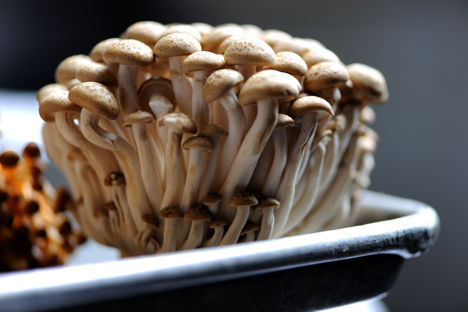
Be a fun-guy with your mushrooms
Hayden Groves delves into one of his favourite activities, foraging, to uncover some of the 4000 species of fungi. He shares the best ways to cook and prepare them.
Be a fun-guy with your mushrooms
Hayden Groves delves into one of his favourite activities, foraging, to uncover some of the 4000 species of fungi. He shares the best ways to cook and prepare them.
For the master forager, fungi, and in particular wild mushrooms, are his preserve and treasure, guarding their favourite spots with much secrecy and returning each season to a woodland or forest with near GPS accuracy. But if you think anyone with a “My First Forage” Ladybird library book can do it - a word of warning, here in the UK alone we have 4000 species that come under the term fungi and not all of them are edible! So on no account pick or eat any mushroom growing in the wild unless you can positively identify it!
Mushrooms can be broken down simply into two sub groups, wild and cultivated. The majority of wild mushrooms are at their peak in the Autumn and have exotic sounding French names such as Pied de mouton, Cepes, Chanterelles and the scarily named Trompette de la Mort (trumpets of death). My thoughts turn to a family holiday a couple of years ago in Romania. It was late August in Transylvania and en route to Dracula’s castle Girolles were in abundance at every forest road layby, picked fresh that morning and in beautiful condition at a ridiculous price of only 6 Euros per kilo!
Spring heralds the arrival of Morels, arguably one of the most treasured and best tasting mushrooms. I absolutely love Morels, their flavour is unique. St Georges mushroom is another, which as the name suggests, is available around our patron saint's day in mid April
Cultivated are available all year round, and are far from limited to just button. Supermarkets these days stock several varieties such as oyster, shitake and Portobello. Sometimes there is a touch of snobbery around mushrooms on restaurant menus, but in my opinion the humble chestnut mushroom cooked and seasoned well can deliver far more than one of their wild cousins poorly cleaned, gritty and not cooked with love and understanding.
Dried are readily available all year round, they are excellent added to soups, stews and risottos. As the drying process concentrates their flavour, only a few are needed to enhance the flavour of a dish. Steep the dried mushrooms in hot water for 30 minutes minimum, remove the rehydrated mushrooms and pour off the flavour packed liquor to add to your recipe, reserving ½ tsp or so as this can be gritty.
When preparing mushrooms opinion is divided over whether to lightly rinse them or simply wipe with a damp cloth. For myself, if they are cultivated, a simple wipe is all that’s needed. If they’re the wild variety they should always be cleaned carefully before cooking with the briefest wash in a bowl of warm water, then left on an absorbent cloth.
There’s no need to peel mushrooms or remove the stems before cooking unless they’re particularly thick or discoloured. If you do, keep the trimmings to make a very simple stock for a risotto or soup by roughly chopping them and adding a shallot, a sprig of herb and some vegetable or chicken stock and gently simmering for 15 minutes, strain off and you’re good to go.
Butter, cream, parsley, fresh thyme, shallots and garlic all go well with mushrooms. When I sauté mushrooms I like to use butter and a glug of olive oil. At the end of the cooking process a tablespoon of white chicken stock or even water creates an emulsion and coats the mushrooms. Depending on the dish a fine dice of shallot, garlic and a few thyme leaves really help for an extra layer of flavour.
Rather than just a ‘big ol boy’ grilled next to your bacon and sausage fry up, why not try something a little different? Seek out one of the other varieties from the wild side. They’re great in sauces, risottos and stews and even pickled or raw in salads. Be a “Fun-Guy” with your mushrooms, the only limitations are what you set yourself, as I often say.


